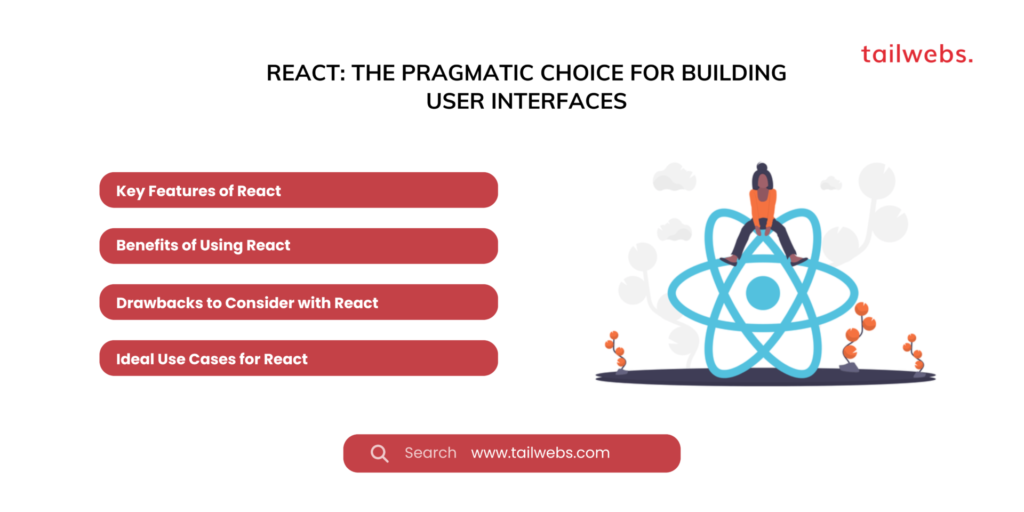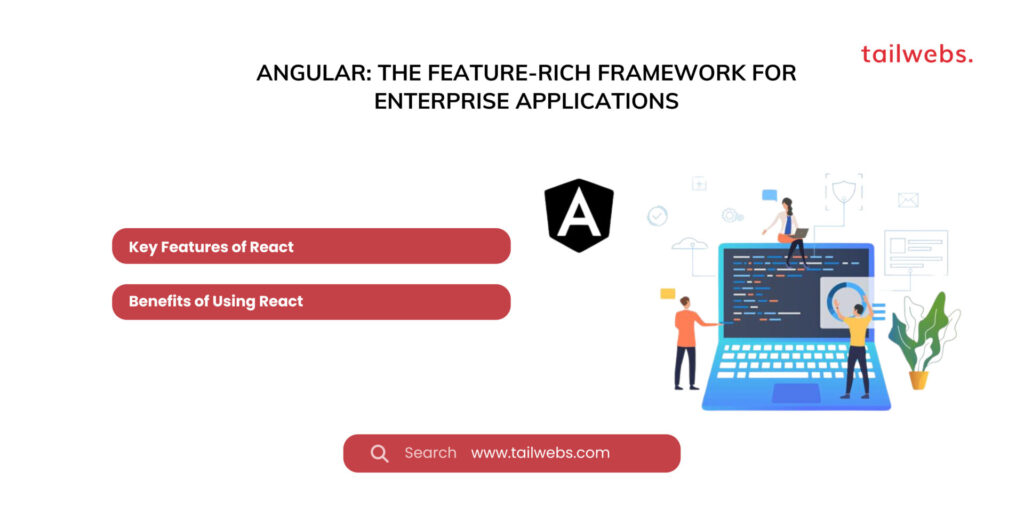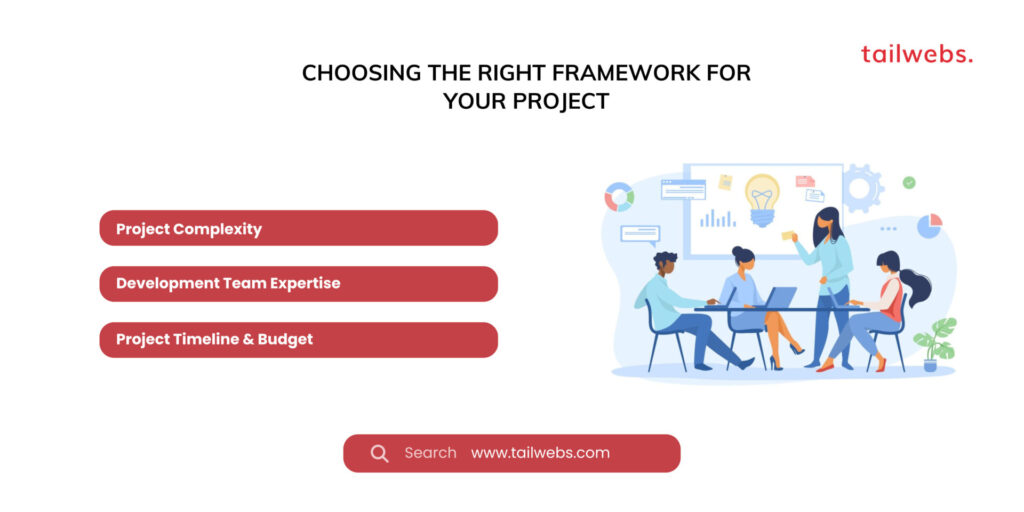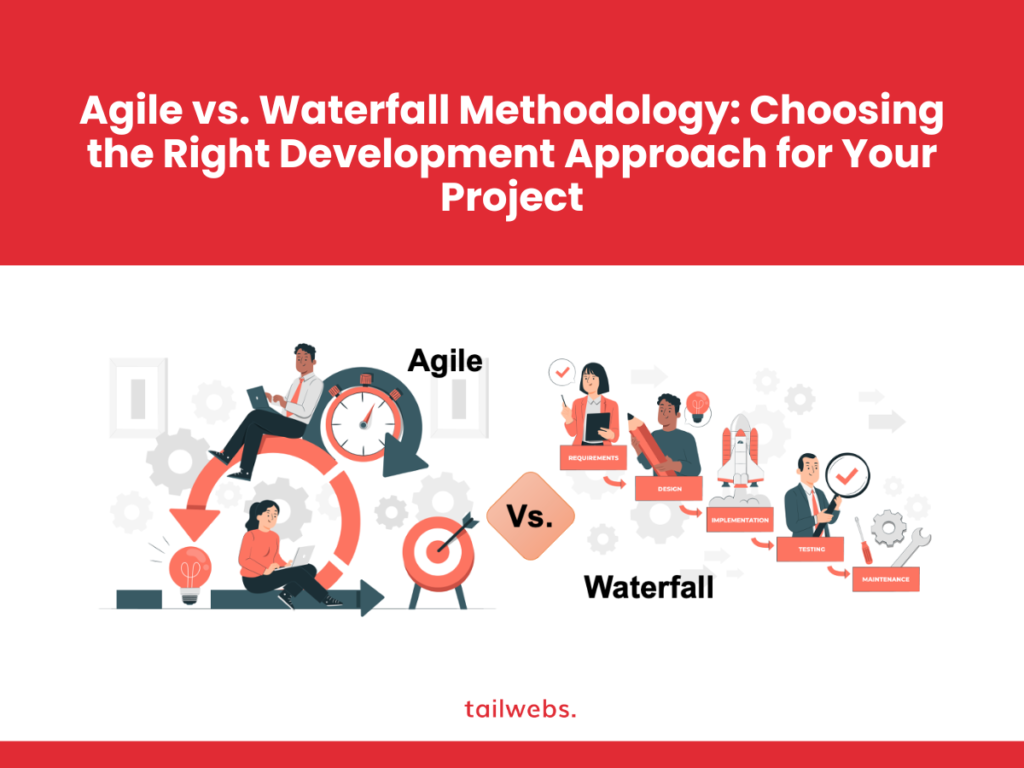Modern web development landscape, frameworks play a pivotal role in streamlining the development process, fostering code maintainability, and building robust, interactive user interfaces. Three frameworks reign supreme: React, Angular, and Vue.js. Each boasts unique strengths and caters to different project needs. This comprehensive guide delves into the core functionalities, pros and cons, and ideal use cases of these modern web development frameworks, empowering you to make an informed decision for your next project.
React: The Pragmatic Choice for Building User Interfaces
Developed by Facebook, React is a declarative, open-source JavaScript library for building user interfaces (UI) components. Unlike a full-fledged framework, React focuses on component-based architecture, where complex UIs are assembled from independent, reusable components. This modular approach fosters code reusability, maintainability, and efficient development workflows.
Key Features of React for Modern Web Development :
Virtual DOM:
React employs a virtual DOM, a lightweight in-memory representation of the real DOM. When changes occur, React efficiently updates the virtual DOM and identifies the minimal changes required in the real DOM, resulting in a performant and optimized UI rendering process.
JSX (JavaScript XML):
JSX allows you to write HTML-like syntax within your JavaScript code, improving readability and maintainability of UI components. However, JSX is a syntactic extension and can be transpiled to plain JavaScript for broader browser compatibility.
Unidirectional Data Flow:
React adheres to a unidirectional data flow architecture. Data is passed down from parent components to child components as props, promoting predictable state management and easier debugging.
Benefits of Using React:
Performance:
React’s virtual DOM and component-based architecture contribute to exceptional rendering performance, making it ideal for complex and dynamic user interfaces.
Flexibility:
React offers a high degree of flexibility. Developers can choose from a vast ecosystem of third-party libraries and tools to tailor their development workflow and integrate functionalities specific to their project needs.
Large Community & Ecosystem:
Boasting a massive and active developer community, React offers extensive learning resources, tutorials, and readily available components, accelerating development and problem-solving.
Drawbacks to Consider with React for Modern Web Development :
Learning Curve:
While React itself has a relatively gentle learning curve, the vast ecosystem of libraries and tools can be overwhelming for beginners.
State Management Complexity:
For complex applications, managing application state across components can become challenging. Developers often need to integrate additional state management libraries like Redux or MobX.
Focus on UI Layers:
React primarily concerns itself with building UI components. For complex applications with intricate backend logic and data management, additional frameworks or libraries might be needed.
Ideal Use Cases for React:
Single-Page Applications (SPAs):
React excels at building interactive and dynamic SPAs that provide a seamless user experience.
Large-Scale Web Applications:
The component-based architecture promotes code reusability and maintainability, making React well-suited for building complex web applications with evolving functionalities.
UI Component Libraries:
React’s modularity makes it a popular choice for developing reusable UI component libraries that can be integrated into various projects.

Angular: The Feature-Rich Framework for Enterprise Applications
Developed and maintained by Google, Angular is a TypeScript-based, open-source framework for building web applications. Unlike React, Angular is a full-featured framework offering a comprehensive set of tools and functionalities out of the box. This includes features for routing, dependency injection, forms management, and more, streamlining development for complex applications.
Key Features of Angular:
Two-Way Data Binding:
Angular employs two-way data binding, meaning changes in the UI automatically update the underlying data model, and vice versa. This simplifies data flow management but can introduce complexity in large applications.
Dependency Injection:
Angular promotes a dependency injection architecture where components don’t create their own dependencies but rely on an injector to provide them. This fosters loose coupling and testability.
Built-in Features:
Angular offers a rich set of built-in features for routing, forms management, HTTP services, and more, reducing the need for external libraries and accelerating development.
Benefits of Using Angular:
Structure & Scalability:
Angular’s comprehensive structure and built-in features are well-suited for developing large-scale enterprise applications with complex functionalities and data management needs.
Improved Developer Productivity:
The framework’s features and tooling streamline development workflows, allowing developers to focus on core application logic rather than building infrastructure from scratch.
Type Safety (with TypeScript):
By using TypeScript, Angular promotes type safety,

Vue.js: The Versatile Choice for Building Interactive Web Interfaces
Vue.js, pronounced “view” dot “js,” is a progressive, open-source JavaScript framework for building user interfaces. Created by Evan You, formerly of Google’s Angular team, Vue.js strikes a balance between the flexibility of React and the structure of Angular. It offers a core library for building UI components and can be incrementally adopted or scaled into a full-fledged framework for complex applications.
Key Features of Vue.js:
Templating System:
Vue.js utilizes a simple and intuitive templating system that allows you to define the structure of your UI components using HTML-like syntax. This lowers the barrier to entry for beginners familiar with HTML.
Reactive System:
Similar to React, Vue.js employs a reactive system where data changes are automatically reflected in the UI. However, Vue.js offers a more lightweight implementation compared to React’s virtual DOM.
Modular & Composable:
Vue.js promotes a modular approach with reusable components. The framework can be gradually integrated into existing projects or scaled into a comprehensive solution for building single-page applications (SPAs).
Benefits of Using Vue.js:
Ease of Use:
Vue.js boasts a gentle learning curve, making it an excellent choice for beginners or projects requiring a quick start. The intuitive templating system and well-documented features contribute to its user-friendliness.
Flexibility & Scalability:
Vue.js offers flexibility. You can choose to use the core library for basic UI components or leverage its ecosystem of tools and libraries to build feature-rich SPAs.
Performance:
The lightweight nature of Vue.js contributes to its performance, making it suitable for various web application types.
Drawbacks to Consider with Vue.js:
Smaller Community Compared to React & Angular:
While Vue.js boasts a growing and active community, it might not have the same breadth of resources and readily available libraries compared to React and Angular.
Enterprise Suitability:
For very large-scale enterprise applications with extensive backend logic and complex data management, Angular’s comprehensive structure might be a better fit.
Evolving Ecosystem:
As Vue.js continues to mature, its ecosystem of tools and libraries is still evolving. This can mean slightly less readily available solutions compared to more established frameworks.
Ideal Use Cases for Vue.js:
Rapid Prototyping:
The ease of use and flexibility make Vue.js a great choice for quickly prototyping web applications and validating ideas.
Small to Medium-Sized Web Applications:
Vue.js excels at building interactive and performant web applications without the complexity of a full-featured framework.
Single-Page Applications (SPAs):
Vue.js can be effectively scaled to build feature-rich SPAs with a focus on user experience and interactivity.
Choosing the Right Framework for Your Project
The ideal framework selection hinges on your specific project requirements:
- Project Complexity: For intricate enterprise applications with rigorous data management needs, Angular’s structure and built-in features might be advantageous.
- Development Team Expertise: If your team is new to web development frameworks, Vue.js or React’s gentler learning curves might be preferable.
- Project Timeline & Budget: For rapid prototyping or projects with tight deadlines, Vue.js or React’s flexibility could expedite development.

The Future of Web Development Frameworks
The web development landscape is constantly evolving. Here are some key trends to watch:
Focus on Developer Experience:
Frameworks will continue to prioritize developer experience by offering intuitive syntax, streamlined workflows, and improved tooling.
Progressive Enhancement & Web Components:
The rise of progressive enhancement and web components fosters interoperability between frameworks and promotes reusable UI components.
Integration with Emerging Technologies:
Expect frameworks to embrace new technologies like artificial intelligence (AI) and the Internet of Things (IoT), enabling the development of next-generation web applications.
Conclusion: Finding the Perfect Fit
By understanding the core strengths, considerations, and ideal use cases of React, Angular, and Vue.js, you can make an informed decision for your next web development project. Remember, the “best” framework doesn’t exist in a vacuum. Evaluate your project needs, team expertise, and long-term vision to choose the framework that empowers you to build exceptional web applications.





